11 Ways to Speed Up Google Chrome
One of the most popular web browsers users love is Google Chrome, yet in spite of all the feature updates and bug-fixes, Chrome can be slow at times because of some of its features, extensions or applications.
The good news is that there are various tips and tricks, and hacks that help to improve the overall speed and sensitivity of this browser, which subsequently can improve its page loading and web browsing speeds. In this post we will be looking at 11 ways to help speed up your Chrome.
5 (More) Useful Chrome DevTools Tips for Developers
Google Chrome comes with a handy set of web development tools in the form of DevTools (The Chrome... Read more
Get Rid of What You Don’t Need
These tips and tricks disable various unnecessary and unneeded features of Chrome to allow the browser to load web pages faster. These include extensions, plugins and web apps you don’t need.
1. Disable Avoidable Extensions
Extensions are tools that extend the functionality of the Chrome browser, which are helpful yet some may actually be less helpful than you think. Extensions mostly run in the background, and parse or filter web pages before they’re displayed on the screen, but will also load their own pack of data from the Internet.
To get better browsing speeds and good response times, disable and/or delete extensions you don’t actually need.
To disable extensions you do not need:
- Type “chrome://extensions” in your Chrome’s location bar. Alternatively, you can go to Chrome’s Options > More tools > Extensions.
- Untick the Enabled to the extensions you want to disable, or click the Trash icon to delete the extension.
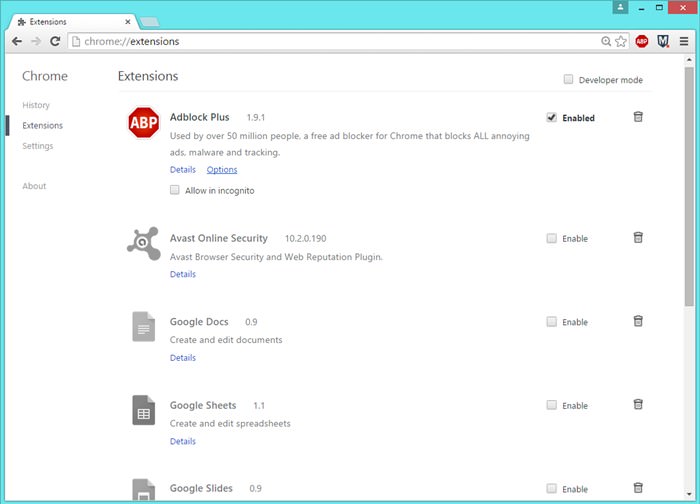
2. Disable Unnecessary Plugins
Plugins are much like extensions. They provide extended functionalities to the browser. Chrome comes with few built-in plugins provided by Google (like Chrome PDF Viewer, Native Client, etc.), and may carry plugins by other software installed in your computer. Plugins, like extensions, can slow down the browser and clog memory and network resources.
To disable plugins you do not need:
- Type “chrome://plugins” in your Chrome’s address bar.
- Click Disable to disable the plugin you no longer need.
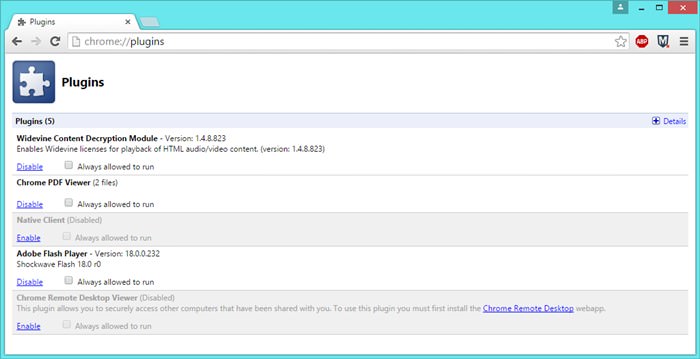
3. Remove Unnecessary Web Apps
Google Chrome is not just a web browser. It’s also an application platform for web apps. It can run locally-installed web apps written using HTML5, CSS, and JavaScript. While web apps don’t load resources like websites do, if you don’t need them, shed them.
To remove unnecessary web apps:
- Type “chrome://apps” in your Chrome’s address bar or click Apps on the Bookmarks bar
- Right-click the app you want to remove, select Remove from Chrome…, and click the Remove button to confirm the removal

4. Enable Prefetch Resources
Google Chrome comes with many intelligent features such as network prediction, spelling correction, resource preloader, etc. Resource pre-fetcher or preloader provides intelligent suggestions about the pages or links the user is most likely to open next, loading those pages/links in the background before you actually open them.
To enable the prefetch feature in Chrome browser:
- Head over to Chrome’s Options > Settings > Show advanced settings…
- Check the “Prefetch resources to load pages more quickly” option.

Enable Secret Hacks
Google Chrome packs many secret and experimental features under its hood. These are experiments by the Chrome’s developer team – some may not be built for novice users, some may not work for some devices, and some may not be good for your computer too.
But lucky for us there are some experiments that are useful enough to boost the browser’s page-loading and rendering engines.
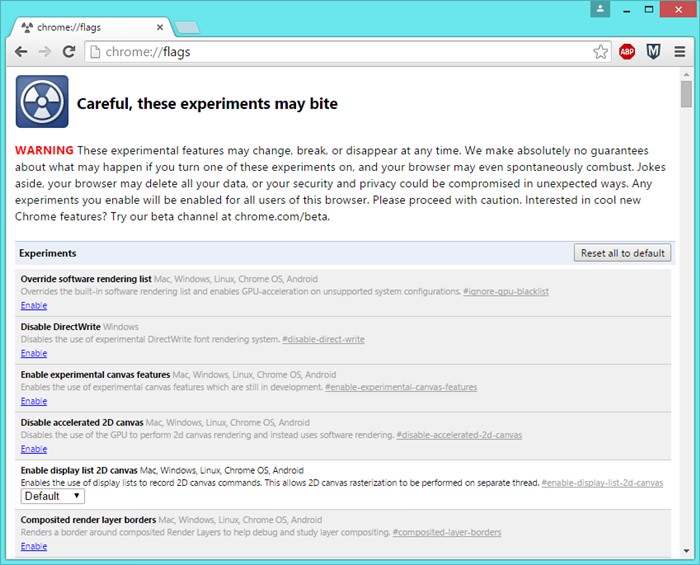
Again, some of them may not work for some devices, and if you find yourself in a situation like this, just undo the hack to go back to normal.
5. Experimental Canvas Features
Experimental Canvas Features allow the Chrome to make use of opaque canvases to amplify the loading times and boost performance.
To enable experimental canvas features:
- Go to “chrome://flags/#enable-experimental-canvas-features“.
- Click on Enable and then Relaunch Now button
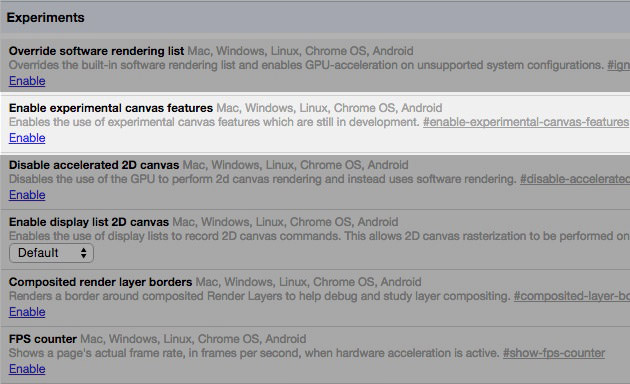
6. Fast Tab/Window Close
The Fast Tab/Window Close option increases the response time of the browser when a user tries to close tabs or windows. Enabling this feature runs a tab’s onUnload.js handler independently of the graphical interface and speeds up the closing process.
To enable fast tab/window close feature:
- Type “chrome://flags/#enable-fast-unload” in the address bar
- Click on Enable and then Relaunch Now button

7. Scroll Prediction
Scroll Prediction feature tells the Chrome browser to predict the finger’s future position during scrolls allowing the engine to render the frame before the page is scrolled again.
To enable Scroll Prediction:
- Type “chrome://flags/#enable-scroll-prediction” in the location bar
- Click on Enable and then Relaunch Now.
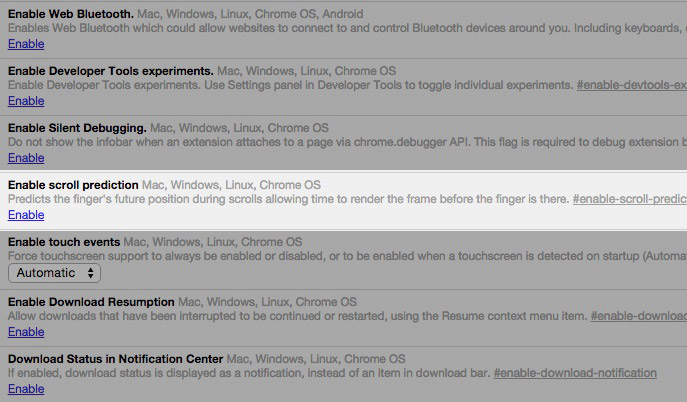
8. Maximum Tiles
Maximum Tiles refers to the tiles for interest area. Increasing the maximum number of tiles allows Chrome to show more tiles based on your interests or browsing history, which allows you to quickly open a new website from the interest area.
To increase the number Maximum Tiles:
- Head over to “chrome://flags/#max-tiles-for-interest-area” in your browser
- Choose 512 from the dropdown. Click Relaunch Now.
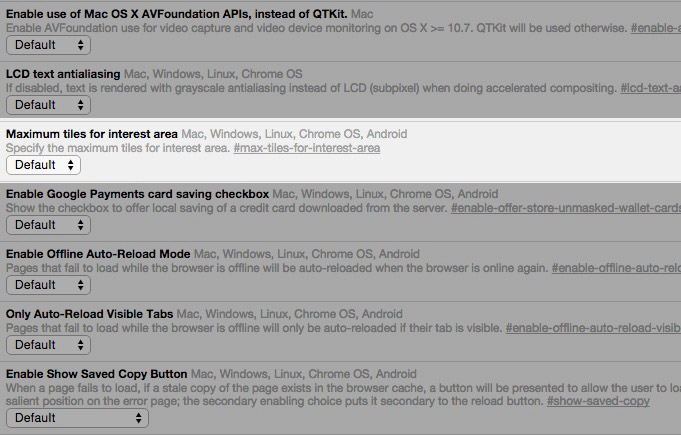
9. Raster Threads
Raster Threads are responsible for rendering images in Chrome . Increasing the number of raster threads improves the image rendering time, and thus influences page loading time.
To increase the number of raster threads:
- Open “chrome://flags/#num-raster-threads” in Chrome.
- Select 4 from the dropdown menu and click Relaunch Now.

10. Answers in Suggest
The “Answers in Suggest” feature allows Chrome to show responses to certain types of queries (mostly questions) directly in the Omnibox’s suggestion list. After enabling this feature, you no longer need to wait for the page to load to see answers for your queries.
To enable Answers in Suggest:
- Type “chrome://flags/#answers-in-suggest” in the location bar.
- Select Enabled from the dropdown. Click Relaunch Now button.
11. Simple Cache for HTTP
Simple Cache is the new caching mechanism for Google Chrome. It works better than the old caching system, relying on the filesystem for space allocation.
To enable Simple Cache:
- Go to “chrome://flags/#enable-simple-cache-backend” in your browser.
- Select Enabled from the dropdown. Click Relaunch Now button.
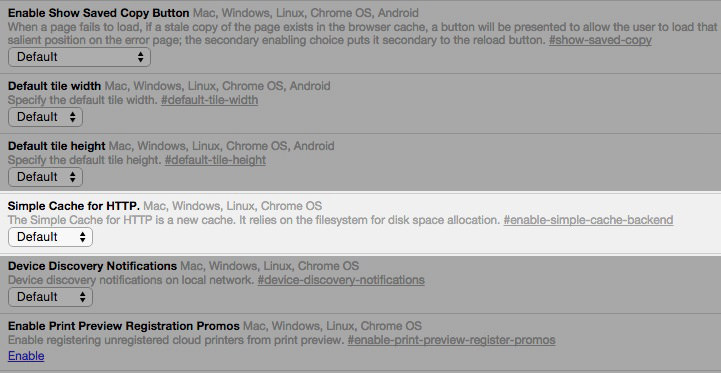
Wrap Up
How’s your browsing experience using Chrome after following these tips and tricks? Do you any more tips & tricks or hacks to speed up Google Chrome?
Please let us know using comments.